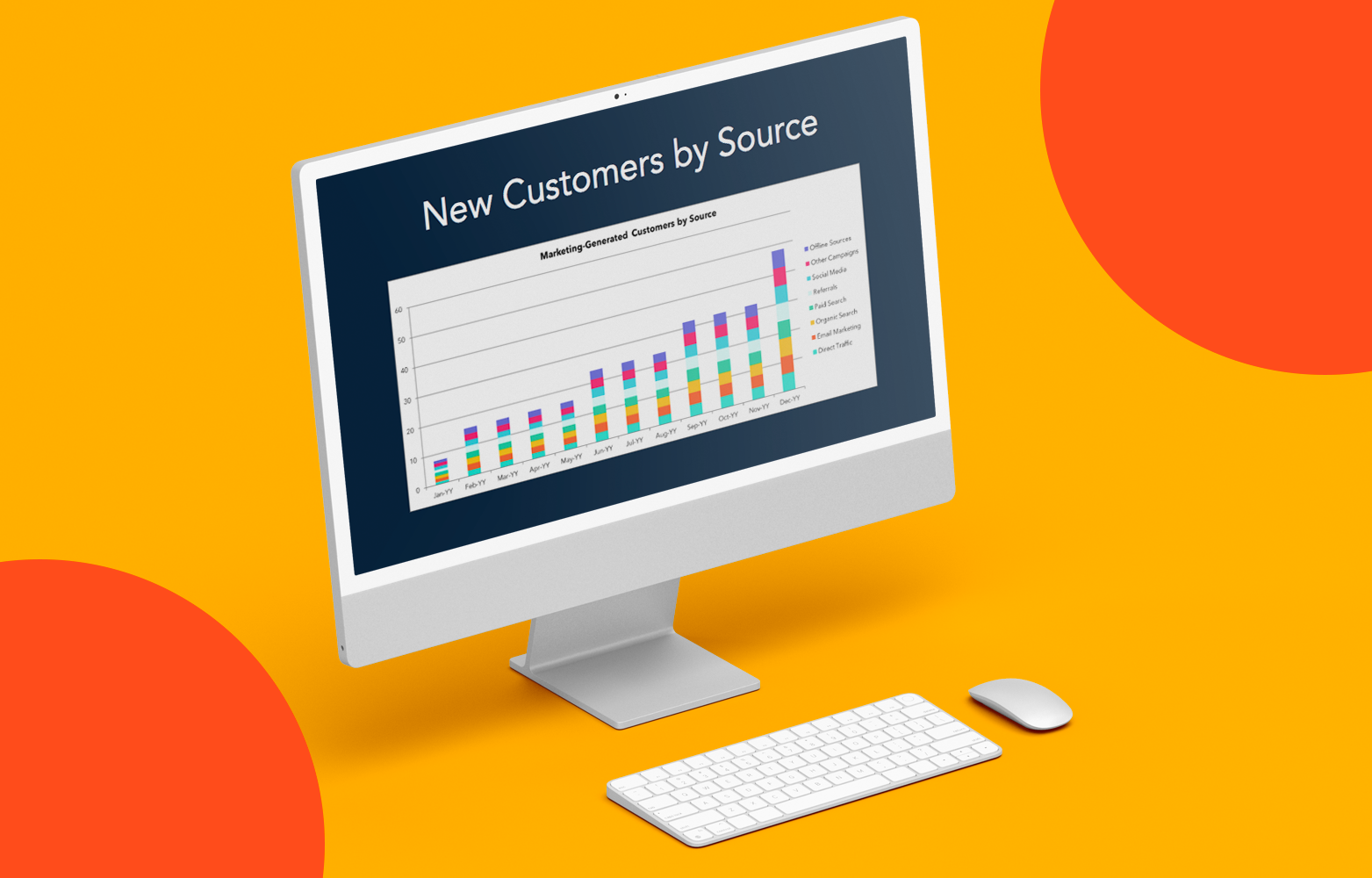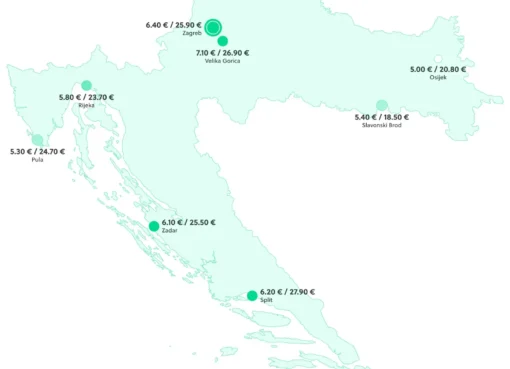Chief Financial Officers (CFOs) are wired to want proof, not promises. While we marketers light up at impressions, and engagement — excuse the stars in my eyes — CFOs focus on revenue, risk, and return.
![→ Free Download: Free Marketing Reporting Templates [Access Now]](https://no-cache.hubspot.com/cta/default/53/0d883e85-c2e5-49bb-bef2-bfddb500d84b.png)
This clash of professional love languages can create friction in budget conversations, performance reviews, and board meetings.
I’ve experienced this tension too many times to count, over the years. My teams knew that sales couldn’t have closed without our marketing, but with so many touchpoints and an evolving data climate, it became increasingly difficult to prove.
Thankfully, we’ve found our ways. This guide will share exactly how to use automated attribution reporting to show finance the metrics they want, bridge the communication gap between departments, and ultimately win the budget you deserve.
Table of Contents
- Why does pipeline influence reporting matter?
- What metrics do CFOs actually care about?
- Which attribution models do CFOs prefer?
- How to Show Marketing’s Impact to the CFO Step-by-Step
- How to Handle Long Sales Cycles and Multi-year Deals in Pipeline Value Reporting
- Addressing Dark Funnel and Offline Attribution
Why does pipeline influence reporting matter?
Simply put, pipeline value attribution matters because it shows why you’re worth the investment. I mean, if a business is spending more than it’s making with any effort, it isn’t financially wise, right? That’s why CFOs need to see the numbers.
But why is it especially important for marketing to prove its value?
As any seasoned marketer will tell you, marketing is often seen as a money pit. Small businesses often assign marketing tasks to existing team members, or worse, they’re the first to be ignored when faced with a tight budget.
In fact, Marketing Week’s Career & Salary Survey last year found that close to half of brands view marketing as a “cost” rather than an “investment.”
I’d argue this is because many marketing mediums can’t be tracked accurately. For instance, if someone sees a paid ad for one of your in-person events, attends, and then follows your blog for a month before contacting sales, what channel gets the credit?
With so many different, intersecting touchpoints, it’s notoriously difficult to attribute credit where it belongs.
To be honest, as a marketer, it’s exhausting, but smart attribution reporting can help mitigate these issues and get us our due and dollars from financial leaders.
Now, I know what you’re thinking: “How do I show marketing’s impact to the CFO? How do I prove marketing drives revenue? How do I get budget approved?” That all starts with understanding what metrics and attribution models CFOs want to see.
What metrics do CFOs actually care about?
|
Traditional Marketing Metrics |
CFO-Focused Revenue Metrics |
|
MQLs |
Qualified pipeline sourced |
|
Website traffic |
Revenue contribution by channel |
|
CTR / Engagement rate |
Marketing ROI (MROI) |
|
Impressions / Reach |
CAC and CAC Payback Period |
|
Email open rate |
Customer Lifetime Value (CLV) |
|
Social shares |
Pipeline velocity (conversion speed) |
|
Attribution clicks only |
Multi-touch revenue attribution |
We marketers get pretty excited about likes and views, but those will likely leave your finance folks unimpressed.
CFOs prioritize financial efficiency and scalability, not just volume or exposure. Many marketing teams focus on performance indicators like MQLs, website traffic, or engagement rates, but CFOs prioritize metrics that directly relate to bottom-line outcomes.
As Todd Morris, InMarket CEO, explains, “CFOs have all these measures that matter [to them], and unfortunately, marketers don’t always have an aligned sense of what those same metrics are for them….CFOs [will] appreciate the beautiful commercial… but they’re going to want to know, ‘for every dollar I invested, what did I get back?’”

In other words, marketers need to learn how to speak CFO. Here are eight finance-approved metrics to showcase in your marketing ROI reporting:
- Marketing-sourced revenue: This measures how much revenue was directly generated by marketing campaigns and programs. It’s the clearest signal that marketing is not just a cost center, but a revenue engine.
- Marketing-influenced pipeline: This tracks how much pipeline value marketing contributed to through activities such as nurturing, retargeting, or event promotion. CFOs appreciate this metric when paired with a sourced pipeline to show broader impact.
- Revenue per lead: Calculating the average revenue generated per lead provides a straightforward efficiency metric. It helps finance compare marketing’s performance against other acquisition channels.
- Marketing ROI (MROI): MROI is the ratio of revenue generated to the cost of marketing. For CFOs, it’s a crucial efficiency metric that demonstrates whether investments are producing returns.
- CAC (Customer Acquisition Cost) payback period: This metric reveals how long it takes for revenue from a customer to cover the cost of acquiring them. A short payback period signifies high marketing efficiency, which CFOs value in budgeting decisions.
- LTV:CAC ratio: The ratio of customer lifetime value (LTV) to acquisition cost. A healthy ratio (typically 3:1 or greater) signals sustainable growth and scalable marketing.
- Pipeline velocity: This measures how quickly leads move through the pipeline. Faster velocity means a quicker return on marketing spend, which finance leaders find valuable.
- Forecast accuracy vs actuals: Marketing teams that can forecast pipeline and revenue accurately demonstrate maturity, reliability, and strategic alignment. CFOs see this as a sign of operational discipline.
Pro tip: Need some help determining your marketing budget to begin with? Check out the steps outlined in our article, “Revenue Marketing: What It Is and Why It Matters”
Which attribution models do CFOs prefer?
Next, it’s important to understand attribution models. There is a wide variety of attribution models that assign credit to different marketing touchpoints.
This affects how they demonstrate ROI, handle channel conflict, address long sales cycles or multi-year deals, and ultimately what information is communicated to CFOs.

Here’s a breakdown of the most common:
- First-touch attribution: This model gives 100% of the credit to the first marketing interaction. While useful for understanding initial awareness drivers, CFOs often dismiss it because it ignores the nurturing and decision-making phases. It also doesn’t speak to long sales cycles.
- Last-touch attribution: This assigns all credit to the final interaction before conversion. Like first-touch, it oversimplifies the buyer journey and is rarely sufficient for financial evaluation.
- Multi-touch attribution: Multi-touch attribution takes into account every channel and touchpoint that a customer interacted with before converting. This is a great solution for addressing channel conflict because it evaluates and weighs touchpoints differently as well as provides insight into how they worked together to influence a customer.
- Linear attribution: This distributes credit equally across all touchpoints. It provides a balanced view but doesn’t account for varying influence levels of each touchpoint, which limits strategic value.
- Time-decay attribution: More credit is given to interactions closer to the conversion. This model is useful for long sales cycles, highlighting the final nudges that convert prospects. CFOs value its logical progression, but it also may minimize the influence of early marketing touches.
- W-shaped attribution: This gives heavier weight to three key moments: first interaction, lead conversion, and opportunity creation. It aligns well with sales stages and is favored by finance for its structure.
- Custom attribution: Custom models assign weights based on actual revenue impact and business logic. When built collaboratively with finance and RevOps, these models are the most CFO-friendly and suitable for board-level reporting.

Source
Regardless of which model you choose, remember: CFOs tend to care less about which campaign touched a lead first and more about how marketing influences revenue outcomes across the entire buying journey.
This speaks to the importance of your work from awareness to sale, rather than just focusing on first impressions.
How to Show Marketing’s Impact to the CFO Step-by-Step
1. Choose your attribution model.
With everything we discussed earlier, determine which attribution model would be best for your needs. Not sure? Ask your financial leadership flat out what is most important to them.
2. Set up your attribution reporting.
Attribution reporting is complicated. Manual spreadsheets and one-off presentations lack credibility with their room for human error and are difficult to scale.
Thankfully, there are many tools to help make it easier these days. In fact, with HubSpot’s Marketing Hub you can even automate your attribution report to do things like:
- Tie marketing activities directly to closed revenue deals
- Attribute influence across first, lead-creating, and deal-creating touchpoints
- Integrate with CRM for accurate, real-time reporting
- Offer multi-touch views that align with actual buying behavior
This automated attribution creates a consistent system CFOs can rely on and trust — a foundational step in earning their confidence. Plus, it just streamlines your workflow.
Glints, a tech career development company in Southeast Asia, improved its reporting efficiency and increased lead conversion rate by 40% by using HubSpot.
2. Create visuals of marketing’s revenue impact.
Visuals are powerful. They make it easier to digest complicated information and are more engaging and memorable than just numbers on a report. That said, take the time to create board-ready visualizations of your data (i.e. charts, graphs, pie charts).
Some popular graphs you may want to include in your report:
- Campaigns with highest sourced revenue
- Marketing-attributed revenue quarter over quarter
- CAC trends and MROI breakdowns by channel
- Pipeline movement and velocity
Providing these dashboards in a CFO-friendly layout (clear, concise, and data-rich) builds confidence that marketing is accountable and aligned with company goals.
Pro tip: In Marketing Hub, our native dashboards often help accomplish this without any additional work. Just pull up what you need and screencap. If you’re feeling extra creative, you can also use Canva to create custom visuals.
3. Preempt CFO concerns with finance-ready narratives.
Even with the numbers to back you up, there are bound to be some skeptics who still need convincing.
When presenting your reports to your CFO, anticipate objections and have data-driven answers ready. Here’s how you can respond to some of the most common concerns and questions:
|
CFO Concern |
Marketing Response |
|
“You can’t prove ROI.” |
“Here’s our sourced pipeline over 3 quarters via HubSpot attribution.” |
|
“What about long sales cycles?” |
“We track touchpoints across the entire lifecycle using multi-touch attribution.” |
|
“Channel conflicts?” |
“We report both first and W-shaped influence to show shared impact.” |
|
“Offline events?” |
“We log event attendance and sales follow-up in CRM for attribution.” |
|
“Dark funnel?” |
“We’re tracking anonymous activity via intent tools and matching CRM entries.” |
This kind of preparation makes marketing a strategic partner in growth conversations.
How to Handle Long Sales Cycles and Multi-year Deals in Pipeline Value Reporting
B2B deals can sometimes stretch over 12, 18, or even 24 months. That doesn’t mean marketing’s influence disappears, of course — but it does require some even more thoughtful modeling.
Multi-touch attribution is my personal favorite as it acknowledges every touchpoint that went into a deal while drawing attention to the most impactful.
For instance, the New Breed marketing team used HubSpot’s multi-touch attribution reporting tools to prove a 79.8% increase in attribution to their blog posts and 88.4% increase in attribution to marketing emails.
With this proof of ROI thanks to HubSpot, they were able to increase their marketing headcount by 33.3% and their budget by 71.2% the following year.
Time-decay attribution is another good option. This model can highlight sustained influence and late-stage nudges. You can pair this with CRM data, including:
- Lead source and original campaign
- Opportunity creation date
- Sales cycle duration
- Close date and revenue value
Segment attribution by product tier, vertical, or persona can also be used to create granular stories. Whichever you choose, these breakdowns help CFOs see where marketing investments are working overtime, even if they don’t convert immediately.
Addressing Dark Funnel and Offline Attribution
The modern funnel includes touchpoints you can’t always track in a standard analytics suite. Marketers are getting less access to browsing and private data, and heck, some interactions happen without ever knowing (i.e., word of mouth).
You’re basically in the dark — hence the name “dark funnel.” CFOs want to see that you’re still acknowledging and accounting for these. So, what can you do?
- Log offline events manually within your CRM.
- Use UTM parameters and call tracking to bridge gaps between online and offline.
- Document ABM outreach, dinner invites, podcast appearances—anything that impacts buying behavior.
When CRM and attribution tools can’t cover everything, build custom fields and reporting views that combine qualitative input (from sales) with quantifiable data (from campaigns).
Secure your marketing budget with buy-in.
The smartest marketing teams don’t just generate leads — they generate revenue and can prove it. By implementing automated attribution reporting, visualizing impact through board-ready dashboards, and aligning narratives with finance language, you reposition marketing as a revenue engine.
HubSpot makes this transition seamless, with attribution tools, CRM integration, and transparent reporting that CFOs trust.
Ready to prove marketing’s revenue impact? Start with Attribution Reporting in HubSpot






![The Top Goals of Marketing Managers & Leaders in 2025 [New Data + Expert Tips] the-top-goals-of-marketing-managers-&-leaders-in-2025-[new-data-+-expert-tips]](https://blog.contentkrush.com/wp-content/uploads/2024/11/140581-the-top-goals-of-marketing-managers-leaders-in-2025-new-data-expert-tips-510x369.webp)

![4 Marketing Trends & Strategies That Might Not Survive in 2025 [New Research] 4-marketing-trends-&-strategies-that-might-not-survive-in-2025-[new-research]](https://blog.contentkrush.com/wp-content/uploads/2025/01/140787-4-marketing-trends-strategies-that-might-not-survive-in-2025-new-research-510x369.jpg)
![Sustainable Marketing: Key Principles & How to Leverage It [+ Examples] sustainable-marketing:-key-principles-&-how-to-leverage-it-[+-examples]](https://blog.contentkrush.com/wp-content/uploads/2024/10/140354-sustainable-marketing-key-principles-how-to-leverage-it-examples-510x369.jpg)



![5 Steps to Create an Outstanding Marketing Plan [Free Templates] 5-steps-to-create-an-outstanding-marketing-plan-[free-templates]](https://blog.contentkrush.com/wp-content/uploads/2024/08/140066-5-steps-to-create-an-outstanding-marketing-plan-free-templates-510x369.png)
![2025 CPL and CAC Benchmarks [HubSpot Research] 2025-cpl-and-cac-benchmarks-[hubspot-research]](https://blog.contentkrush.com/wp-content/uploads/2025/02/141036-2025-cpl-and-cac-benchmarks-hubspot-research-510x369.webp)
![What Are the 4 Ps of Marketing? The Marketing Mix Explained [Example] what-are-the-4-ps-of-marketing?-the-marketing-mix-explained-[example]](https://blog.contentkrush.com/wp-content/uploads/2025/02/141030-what-are-the-4-ps-of-marketing-the-marketing-mix-explained-example-510x369.webp)
![What is B2C Marketing? [+ New Data & Trends to Captivate Audiences in 2025] what-is-b2c-marketing?-[+-new-data-&-trends-to-captivate-audiences-in-2025]](https://blog.contentkrush.com/wp-content/uploads/2025/01/140852-what-is-b2c-marketing-new-data-trends-to-captivate-audiences-in-2025-510x369.jpg)

![What’s a Marketing Audit? [+ How To Do One] what’s-a-marketing-audit?-[+-how-to-do-one]](https://blog.contentkrush.com/wp-content/uploads/2025/02/141038-whats-a-marketing-audit-how-to-do-one-510x369.webp)













Comment here